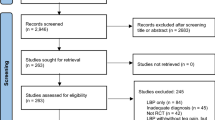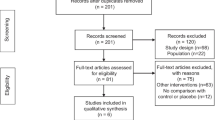Abstract
Purpose
A number of outcome measures (instruments) are used to assess shoulder pain and function in clinical practice. No clear ‘gold standard’ exists and it is thought that different instruments will give a different answer. Our aim is to statistically compare four commonly used outcome measures in a group of trauma patients and to identify whether instruments which combine objective and subjective components differ from those which are purely subjective.
Methods
Forty-four patients undergoing internal fixation of proximal humeral fractures were recruited between 2003 and 2008. Each was asked to complete a number of outcome measures: University of Los Angeles score (UCLA); Constant and Murley score (Constant); Oxford Shoulder Score (OSS); Quick form of the Disabilities of the Arm, Shoulder and Hand questionnaire (QuickDASH). Each were measured on a different scale but were standardised to 0–100 for comparison.
Results
Purely subjective instruments gave higher scores (better function and/or less pain). Statistical differences were found between each pair of instruments (p < 0.001), except for the comparison between UCLA and QuickDASH (p = 0.403). The study found inconsistencies between instruments, with outcomes varying depending on whether subjective or objective measurements were being assessed.
Conclusions
Outcome measures are useful tools, but clinicians need to be aware that their choice of instrument should be made carefully, taking into account the reason behind its use with regard to outcome.
Similar content being viewed by others
References
Beaton DE, Richards RR. Measuring function of the shoulder. A cross-sectional comparison of five questionnaires. J Bone Joint Surg Am. 1996;78:882–90.
Slobogean GP, Slobogean BL. Measuring shoulder injury function: common scales and checklists. Injury. 2011;42:248–52. doi:10.1016/j.injury.2010.11.046.
Harvie P, Pollard TC, Chennagiri RJ, Carr AJ. The use of outcome scores in surgery of the shoulder. J Bone Joint Surg Br. 2005:87:151–4. doi:10.1302/0301-620X.87B2.15305.
Allom R, Colegate-Stone T, Gee M, Ismail M, Sinha J. Outcome analysis of surgery for disorders of the rotator cuff: a comparison of subjective and objective scoring tools. J Bone Joint Surg Br. 2009:91:367–73. doi:10.1302/0301-620X.91B3.20714.
Baker P, Nanda R, Goodchild L, Finn P, Rangan A. A comparison of the Constant and Oxford shoulder scores in patients with conservatively treated proximal humeral fractures. J Shoulder Elbow Surg. 2008;17(1):37–47. doi:10.1016/j.jse.2007.04.019.
Dawson J, Fitzpatrick R, Carr A. Questionnaire on the perceptions of patients about shoulder surgery. J Bone Joint Surg Br. 1996;78:593–600.
Dawson J, Rogers K, Fitzpatrick R, Carr A. The Oxford shoulder score revisited. Arch Orthop Trauma Surg. 2009;129:119–23. doi:10.1007/s00402-007-0549-7.
Beaton DE, Wright JG, Katz JN; Upper Extremity Collaborative Group. Development of the QuickdASH: comparison of three item-reduction approaches. J Bone Joint Surg Am. 2005;87:1038–46. doi:10.2106/JBJS.D.02060.
Constant CR, Murley AH. A clinical method of functional assessment of the shoulder. Clin Orthop Relat Res. 1987;214:160–4.
Amstutz HC, Sew Hoy AL, Clarke IC. UCLA anatomic total shoulder arthroplasty. Clin Orthop Relat Res. 1981;155:7–20.
Christie A, Hagen KB, Mowinckel P, Dagfinrud H. Methodological properties of six shoulder disability measures in patients with rheumatic diseases referred for shoulder surgery. J Shoulder Elbow Surg. 2009;18:89–95. doi:10.1016/j.jse.2008.07.008.
Koukakis A, Apostolou CD, Taneja T, Korres DS, Amini A. Fixation of proximal humerus fractures using the PHILOS plate: early experience. Clin Orthop Relat Res. 2006;442:115–20. doi:10.1097/01.blo.0000194678.87258.6e.
Bot SDM, Terwee CB, van der Windt DA, Bouter LM, Dekker J, de Vet HC. Clinimetric evaluation of shoulder disability questionnaires: a systematic review of the literature. Ann Rheum Dis. 2004;63:335–41. doi:10.1136/ard.2003.007724.
Higginson IJ, Carr AJ. Measuring quality of life: using quality of life measures in the clinical setting. BMJ. 2001;322:1297–300.
Iannotti JP, Bernot MP, Kuhlman JR, Kelley MJ, Williams GR. Postoperative assessment of shoulder function: a prospective study of full-thickness rotator cuff tears. J Shoulder Elbow Surg. 1996;5:449–57.
Kruger J, Dunning D. Unskilled and unaware of it: how difficulties in recognizing one’s own incompetence lead to inflated self-assessments. J Pers Soc Psychol. 1999;77(6):1121–34.
Conflict of interest
None.
Author information
Authors and Affiliations
Corresponding author
Rights and permissions
About this article
Cite this article
Beastall, J.E., Fielding, S., Christie, E. et al. Shoulder outcome measures: is there a right answer?. Eur J Trauma Emerg Surg 38, 659–664 (2012). https://doi.org/10.1007/s00068-012-0220-z
Received:
Accepted:
Published:
Issue Date:
DOI: https://doi.org/10.1007/s00068-012-0220-z




